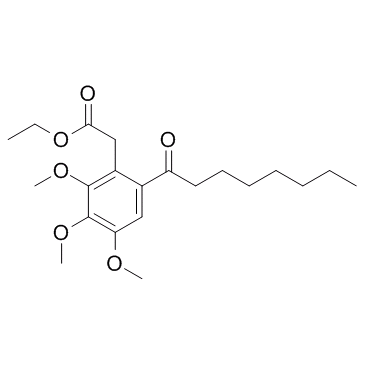Physicochemical Properties
| Molecular Formula | C21H32O6 |
| Molecular Weight | 380.4752 |
| Exact Mass | 380.219 |
| CAS # | 1258275-73-8 |
| Related CAS # | 1258275-73-8 |
| PubChem CID | 60146245 |
| Appearance | Light yellow to yellow solid |
| Density | 1.1±0.1 g/cm3 |
| Boiling Point | 480.0±45.0 °C at 760 mmHg |
| Flash Point | 205.8±28.8 °C |
| Vapour Pressure | 0.0±1.2 mmHg at 25°C |
| Index of Refraction | 1.491 |
| LogP | 5.25 |
| Hydrogen Bond Donor Count | 0 |
| Hydrogen Bond Acceptor Count | 6 |
| Rotatable Bond Count | 14 |
| Heavy Atom Count | 27 |
| Complexity | 438 |
| Defined Atom Stereocenter Count | 0 |
| SMILES | O=C(C1=C([H])C(=C(C(=C1C([H])([H])C(=O)OC([H])([H])C([H])([H])[H])OC([H])([H])[H])OC([H])([H])[H])OC([H])([H])[H])C([H])([H])C([H])([H])C([H])([H])C([H])([H])C([H])([H])C([H])([H])C([H])([H])[H] |
| InChi Key | WCYMJQXRLIDSAQ-UHFFFAOYSA-N |
| InChi Code | InChI=1S/C21H32O6/c1-6-8-9-10-11-12-17(22)15-13-18(24-3)21(26-5)20(25-4)16(15)14-19(23)27-7-2/h13H,6-12,14H2,1-5H3 |
| Chemical Name | ethyl 2-(2,3,4-trimethoxy-6-octanoylphenyl)acetate |
| Synonyms | TMPA |
| HS Tariff Code | 2934.99.9001 |
| Storage |
Powder-20°C 3 years 4°C 2 years In solvent -80°C 6 months -20°C 1 month |
| Shipping Condition | Room temperature (This product is stable at ambient temperature for a few days during ordinary shipping and time spent in Customs) |
Biological Activity
| ln Vitro | TMPA (5, 10, 20, 40, 80 μM; 6 hours or 10 μM; 0.5, 1, 3, 6, 12, 24, 36, 48 hours) antagonizes Nur77-LKB1 ligated TMPA ( 10 μM; 6 hours) improves the LKB1-AMPKα response but lowers the LKB1-Nur77 response in Lo2 cells under physiological conditions [1]. TMPA directly interacts with LBD with a specific structural picture [1]. TMPA (10, 20 μM; 6 h) promotes LKB1 nuclear export and activates AMPKα in Lo2 cells [1]. TMPA (10, 50, 100 μM; 4 h) damages human T cells RICD (restimulation-induced [1]. |
| ln Vivo | In individuals with type II diabetes, TMPA (50 mg/kg; intraperitoneal injection; single dose daily for 19 days) can lower blood pressure and enhance diabetic tolerance [1]. |
| Cell Assay |
Cell viability assay [2] Cell Types: T cell Tested Concentrations: 10, 50, 100 μM Incubation Duration: 4 h Experimental Results: Dramatically diminished T cell RICD (cell death) in a dose-dependent manner [2]. Western Blot Analysis[1] Cell Types: Liver LO2 Cells Tested Concentrations: 10, 20 µM Incubation Duration: 6 hrs (hours) Experimental Results: Experimental Results: Increased LKB1 Ser428 phosphorylation. Western Blot Analysis[1] Cell Types: Liver LO2 cells Tested Concentrations: 5, 10, 20, 40, 80 µM Incubation Duration: 6 hrs (hours) Experimental Results: AmPKα phosphorylation increased in a dose- and time-dependent manner. At a concentration of 10 µM, the LKB1-AmPKα interaction is rescued by reducing the nur77-lKb1 interaction. |
| Animal Protocol |
Animal/Disease Models: Male C57BL/KsJ-Leprdb/Leprdb (db/db ) mice (10 weeks old; type II diabetes model) [1]. Doses: 50 mg/kg Route of Administration: intraperitoneal (ip) injection; daily for 19 days. Experimental Results: Blood glucose diminished Dramatically on day 7 and persisted for the remainder of the test. Increases the amount of phosphorylated AMPKα in mouse liver. |
| References |
[1]. The orphan nuclear receptor Nur77 regulates LKB1 localization and activates AMPK. Nat Chem Biol. 2012 Nov;8(11):897-904. [2]. Modulation of T-cell apoptosis by small molecule compounds targeting the nuclear orphan receptor Nur 77. (2018). |
| Additional Infomation | Ethyl (2,3,4-trimethoxy-6-octanoylphenyl)acetate is an aromatic ketone. |
Solubility Data
| Solubility (In Vitro) | DMSO: ≥ 100 mg/mL (262.8 mM) |
| Solubility (In Vivo) |
Solubility in Formulation 1: ≥ 2.5 mg/mL (6.57 mM) (saturation unknown) in 10% DMSO + 40% PEG300 + 5% Tween80 + 45% Saline (add these co-solvents sequentially from left to right, and one by one), clear solution. For example, if 1 mL of working solution is to be prepared, you can add 100 μL of 25.0 mg/mL clear DMSO stock solution to 400 μL PEG300 and mix evenly; then add 50 μL Tween-80 to the above solution and mix evenly; then add 450 μL normal saline to adjust the volume to 1 mL. Preparation of saline: Dissolve 0.9 g of sodium chloride in 100 mL ddH₂ O to obtain a clear solution. Solubility in Formulation 2: ≥ 2.5 mg/mL (6.57 mM) (saturation unknown) in 10% DMSO + 90% Corn Oil (add these co-solvents sequentially from left to right, and one by one), clear solution. For example, if 1 mL of working solution is to be prepared, you can add 100 μL of 25.0 mg/mL clear DMSO stock solution to 900 μL of corn oil and mix evenly. (Please use freshly prepared in vivo formulations for optimal results.) |
| Preparing Stock Solutions | 1 mg | 5 mg | 10 mg | |
| 1 mM | 2.6283 mL | 13.1413 mL | 26.2826 mL | |
| 5 mM | 0.5257 mL | 2.6283 mL | 5.2565 mL | |
| 10 mM | 0.2628 mL | 1.3141 mL | 2.6283 mL |
